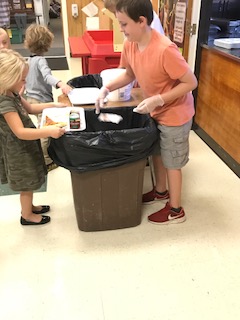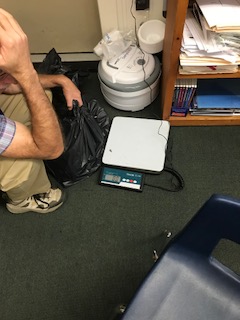Sebago Elementary School principal, Kirsten Goff, received an email in August that intrigued her. NRCM’s “Food Guy,” Ryan Parker, had reached out to the principals of Maine’s K-12 schools with some information about reducing food waste in Maine’s public education system. Principal Goff immediately contacted Ted Bridge-Koenigsberg, who teaches science and language arts at the school. Mr. Bridge, as the students know him, is very interested in reducing waste, and already helps maintain a series of raised beds for the purposes of educating the students about plant life-cycles, insects, experiential learning, and the production of some pretty impressive school snacks, including grapes by the bushel and student-made fruit leather.
Ted and Kirsten met with Ryan before school started to discuss ways the school could reduce the amount of waste generated in the school lunch program. Both Principal Goff and Mr. Bridge were aware of the amount of waste and bothered by it for environmental, economic, and ethical reasons related to throwing away food, much of it perfectly edible. So they decided to begin addressing the problem. In the first weeks of school they’ve created some wildly successful programs that can be held up as models for other schools looking to tackle this problem.

One of the most important steps in reducing food waste is to calculate exactly how much your school is dealing with. In order to do that, you need to have a successful separation routine, in which organic materials are separated from plastics, cardboard, foils, and other recyclables or trash. One of the common concerns some people raise when food waste reduction is broached is that the students won’t be able to separate effectively. It will take too much time; it will cut into an already too-short lunch period; it will create too much mess for the custodial or dining services staff to clean-up, etc. NRCM’s research reveals that, pretty much universally across the country, once begun, it takes about a week for an effective separation protocol to become routine for students. That was certainly on display when NRCM staff was asked to visit the school, assess progress, and offer suggestions for improvement.
Sebago Elementary School has come up with a great way to ensure separation is as efficient as possible and contamination of organic material (one of the biggest challenges for commercial and institutional composting programs) is at a minimum. In the case of this school, that minimum is zero! The best thing about the program, however, isn’t the success in separating, but the manner in which it is accomplished.

Sebago Elementary is a K-5 school. You might imagine the younger end of that spectrum having trouble in some instances with specifics, and logistics, of specialized separation during end-of-lunch disposal times. That’s legitimate. Sometimes these youngsters need a helping hand. But, as is the case in most of the K-12 settings NRCM visits and helps, teachers and other staff are already stretched thin. Sebago Elementary’s solution? Recognize the maturity, and leadership capabilities, of the older students. Fifth grade students recognized by staff to be leaders and helpers oversee and assist with the separation at the end of the lunch period. It’s quite remarkable to see in action!

Right now, in the data collection phase, the food waste that is separated is still being thrown away. That’s ok! When it comes to reducing food waste, it’s important to have all your ducks in a row before embarking on a project like on-site composting. After all, we are talking about food waste, which needs to be handled properly for health, safety, pest aversion, and aesthetic reasons. Also, this phase of a project is instilling in the students the routine. The food is weighed by the students in Mr. Bridge’s third grade science class using a digital scale. Data is recorded and analyzed. It is worth noting that daily totals are almost perfectly in line with, according to NRCM’s research, the average generated in schools across the nation, approximately 36.5 pounds of organics waste per student per year. If you would like an estimate of the amount of food waste generated by your local school, multiply the number of students by 36.5 pounds. When you pick yourself up off the floor, feel free to contact NRCM to learn how we can help you help your local school reduce this waste (which ends up in Maine’s landfills and generates methane gas, 20 times more powerful than CO2 in affecting the climate).
Sebago is now working toward composting at the school. The compost project will involve a collaboration with teachers in other schools to build the compost bins, which will be set up in the school gardens where the finished product can be put to good use, not only producing food for snacks and, eventually, the cafeteria, but also providing further opportunities for beautification of the school grounds with flowers like those pictured below (found in the garden on a beautiful September day).

Principal Goff, Mr. Bridge, and the rest of the staff, and students, at Sebago Elementary are on the right track, already doing great things to change the culture of waste in the cafeteria. They are not only setting up compost but looking at higher levels of the food recovery hierarchy by researching opportunities for share tables and speaking with a local farmer who raises pigs. Congratulations to all involved! We look forward to continuing to work with Sebago Elementary as the staff and students continue to establish themselves as models in the efforts to reduce food waste, food insecurity, and the environmental, economic, and ethical costs if creates.











Leave a Reply